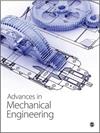Numerical simulation and performance prediction of the ejection impact of air springs
IF 1.9
4区 工程技术
Q3 ENGINEERING, MECHANICAL
引用次数: 0
Abstract
To address the challenges of applying air springs in high-speed rail vehicle ejections, the ejection of a driver’s cabin structure is focused on in this study, and an ejection simulation model of an air spring is proposed using a series-parallel combination. The model’s accuracy is verified through virtual collision analysis of the driver’s cabin in a rail vehicle. The ejection velocity exhibits a relative error of only 9.1%. The test vehicle, driven by an air spring, achieves a maximum kinetic energy of 415 kJ, meeting the initial target value of no less than 408 kJ. Additionally, the analysis of the wheel-rail interaction reveals that the vertical lift and lateral displacement of the test vehicle are within acceptable limits, measuring 5.49 and 9.89 mm, respectively, without exceeding the wheel flange height and tread width. These results demonstrate that an air spring with a series-parallel combination can successfully propel the test vehicle to conduct the driver’s cabin collision tests without any derailment or overturning. Research on the ejection performance of air springs in this configuration offers a new driving and ejection method for applying air springs in rail vehicles, drones, and air-launched missiles, presenting promising prospects for future applications.空气弹簧弹射冲击力的数值模拟和性能预测
为解决在高速轨道车辆弹射中应用空气弹簧所面临的挑战,本研究重点关注了司机舱结构的弹射,并提出了一种采用串并联组合的空气弹簧弹射模拟模型。通过对轨道车辆司机室进行虚拟碰撞分析,验证了该模型的准确性。弹射速度的相对误差仅为 9.1%。由空气弹簧驱动的测试车辆获得了 415 kJ 的最大动能,达到了不低于 408 kJ 的初始目标值。此外,对车轮与导轨相互作用的分析表明,测试车辆的垂直升力和横向位移都在可接受的范围内,分别为 5.49 毫米和 9.89 毫米,没有超出车轮轮缘高度和胎面宽度。这些结果表明,串并联组合的空气弹簧可以成功地推动试验车辆进行驾驶室碰撞试验,而不会出现脱轨或翻车现象。对这种结构的空气弹簧弹射性能的研究为空气弹簧在轨道车辆、无人机和空射导弹中的应用提供了一种新的驱动和弹射方法,为未来的应用带来了广阔的前景。
本文章由计算机程序翻译,如有差异,请以英文原文为准。
求助全文
约1分钟内获得全文
求助全文
来源期刊

Advances in Mechanical Engineering
工程技术-机械工程
CiteScore
3.60
自引率
4.80%
发文量
353
审稿时长
6-12 weeks
期刊介绍:
Advances in Mechanical Engineering (AIME) is a JCR Ranked, peer-reviewed, open access journal which publishes a wide range of original research and review articles. The journal Editorial Board welcomes manuscripts in both fundamental and applied research areas, and encourages submissions which contribute novel and innovative insights to the field of mechanical engineering
 求助内容:
求助内容: 应助结果提醒方式:
应助结果提醒方式:


